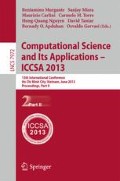Abstract
Inferring community mobility of patients from GPS data has received much attention in health research. Developing robust mobility (or physical activity) monitoring systems relies on the automated algorithm that classifies GPS track points into events (such as stops where activities are conducted, and routes taken) accurately. This paper describes the method that automatically extracts community mobility measures from GPS track data. The method uses temporal DBSCAN in classifying track points, and temporal filtering in removing noises (any misclassified track points). The result shows that the proposed method classifies track points with 88% accuracy. The percent of misclassified track points decreased significantly with our method (1.9%) over trip/stop detection based on attribute threshold values (10.58%).
Access this chapter
Tax calculation will be finalised at checkout
Purchases are for personal use only
Preview
Unable to display preview. Download preview PDF.
References
Evans, C.C., Hanke, T.A., Zielke, D., Keller, S., Ruroede, K.: Monitoring community mobility with Global Positioning System technology after a stroke: a case study. J. Neurol. Phys. Ther. 36(2), 68–78 (2012)
Schenk, A.K., Witbrodt, B.C., Hoarty, C.A., Carlson Jr., R.H., Goulding, E.H., Potter, J.F., Bonasera, S.J.: Cellular telephones measure activity and lifespace in community-dwelling adults: proof of principle. J. Am. Geriatr. Soc. 59(2), 345–352 (2011)
Rainham, D., Krewski, D., McDowell, I., Sawada, M., Liekens, B.: Development of a wearable global positioning system for place and health research. Int. J. Health Geogr. 7(1), 59–75 (2008)
Tudor-Lock, C.: Assessment of enacted mobility in older adults. Top. Geriatr. Rehabil. 28(1), 33–38 (2012)
Srinivasan, S., Bricka, S., Bhat, C.: Methodology for converting GPS navigational streams to the travel-diary data format (2009), http://www.ce.utexas.edu/prof/bhat/ABSTRACTS/Srinivasan_Bricka_Bhat.pdf
Schuessler, N., Axhausen, K.W.: Processing raw data from global positioning systems without additional information. Transp. Res. Record 2105, 28–36 (2009)
Berke, E.M.: Geographic information systems (GIS): recognizing the importance of place in primary care research and practice. J. Am. Board Fam. Med. 23(1), 9–12 (2010)
Peel, C., Baker, P.S., Roth, D.L., Brown, C.J., Bodner, E.V., Allman, R.M.: Assessing mobility in older adults: the UAB Study of Aging Life-Space Assessment. Phys. Ther. 85(10), 1008–1019 (2005)
Stopher, P., FitzGerald, C., Xu, M.: Assessing the accuracy of the Sydney Household Travel Survey with GPS. Transportation 34(6), 723–741 (2007)
Liao, L., Fox, D., Kautz, H.: Extracting places and activities from GPS traces using hierarchical conditional random fields. Int. J. Robot. Res. 26(1), 119–134 (2007)
Liao, L., Patterson, D.J., Fox, D., Kautz, H.: Building personal maps from GPS data. Ann. N. Y. Acad. Sci. 1093(1), 249–265 (2007)
Schoier, G., Borruso, G.: Individual movements and geographical data mining: clustering algorithms for highlighting hotspots in personal navigation routes. In: Murgante, B., Gervasi, O., Iglesias, A., Taniar, D., Apduhan, B.O. (eds.) ICCSA 2011, Part I. LNCS, vol. 6782, pp. 454–465. Springer, Heidelberg (2011)
Carlos, H.A., Shi, X., Sargent, J., Tanski, S., Berke, E.M.: Density estimation and adaptive bandwidths: a primer for public health practitioners. Int. J. Health Geogr. 9(1), 39–46 (2010)
Ester, M., Kriegel, H.P., Sander, J., Xu, X.: A density-based algorithm for discovering clusters in large spatial databases with noise. In: Proceedings of the 2nd International Conference on Knowledge Discovery and Data Mining, KDD 1996, pp. 226–231. AAAI Press (1996)
Stenneth, L., Wolfson, O., Yu, P.S., Xu, B.: Transportation mode detection using mobile phones and GIS information. In: Proceedings of the 19th ACM SIGSPATIAL International Conference on Advances in Geographic Information Systems (ACMGIS 2011), pp. 54–63. ACM (2011)
Cho, G.H., Rodriguez, D.A., Evenson, K.R.: Identifying walking trips using GPS data. Med. Sci. Sports Exerc. 43(2), 365–372 (2011)
Gonzalez, P., Weinstein, J., Barbeau, S., Labrador, M., Winters, P., Georggi, N.L., Perez, R.: Automating mode detection using neural networks and assisted GPS data collected using GPS-enabled mobile phones. In: 15th World Congress on Intelligent Transportation Systems (2008)
Liao, B.: Anomaly detection in GPS data based on visual analytics. In: IEEE Symposium on Visual Analytics Science and Technology (2010)
Mavoa, S., Oliver, M., Witten, K., Badland, H.: Linking GPS and travel diary data using sequence alignment in a study of children’s independent mobility. Int. J. Health Geogr. 10(1), 64 (2011)
Eagle, N., Pentland, A.: Reality mining: sensing complex social systems. Pers. Ubiquit. Comput. 10(4), 255–268 (2006)
Pentland, A., Lazer, D., Brewer, D., Heibeck, T.: Using reality mining to improve public health and medicine. Stud. Health Technol. Inform. 149, 93–102 (2009)
Betts, K.S.: Characterizing exposomes: tools for measuring personal environmental exposures. Environ. Health Persp. 120(4), a158 (2012)
Richardson, D.B., Volkow, N.D., Kwan, M.P., Kaplan, R.M., Goodchild, M.F., Croyle, R.T.: Spatial turn in health research. Science 339(6126), 1390–1392 (2013)
Duncan, M.J., Badland, H.M., Mummery, W.K.: Applying GPS to enhance understanding of transport-related physical activity. J. Sci. Med. Sport 12(5), 549–556 (2009)
Author information
Authors and Affiliations
Editor information
Editors and Affiliations
Rights and permissions
Copyright information
© 2013 Springer-Verlag Berlin Heidelberg
About this paper
Cite this paper
Hwang, S., Hanke, T., Evans, C. (2013). Automated Extraction of Community Mobility Measures from GPS Stream Data Using Temporal DBSCAN. In: Murgante, B., et al. Computational Science and Its Applications – ICCSA 2013. ICCSA 2013. Lecture Notes in Computer Science, vol 7972. Springer, Berlin, Heidelberg. https://doi.org/10.1007/978-3-642-39643-4_7
Download citation
DOI: https://doi.org/10.1007/978-3-642-39643-4_7
Publisher Name: Springer, Berlin, Heidelberg
Print ISBN: 978-3-642-39642-7
Online ISBN: 978-3-642-39643-4
eBook Packages: Computer ScienceComputer Science (R0)

